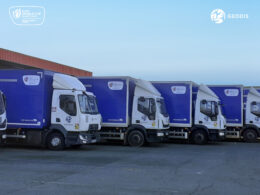 Logistics companies are focusing hard on improving the customer experience. But with driver numbers now at a record low, without a coherent strategy for retaining drivers – and encouraging the younger generation into the workforce – realising customer experience objectives will be impossible.
Logistics companies are focusing hard on improving the customer experience. But with driver numbers now at a record low, without a coherent strategy for retaining drivers – and encouraging the younger generation into the workforce – realising customer experience objectives will be impossible.
Transforming the driver experience will have a measurable business impact – a happy driver not only stays but is also key to transforming the quality of the experience for the end customer.
Driver Value
The logistics industry has a number of challenges to address – not least improving the quality and timeliness of deliveries and the associated customer experience. But for many companies, attempts to drive up performance are being constrained by the on-going challenges of retaining high quality drivers. According to the Council of Supply Chain Management Professionals’ (CSCMP) the shortage of qualified drivers, now at about 30,000, could swell to nearly four times that by 2016. Currently, only about 17 percent of the driver population is under 35.
Given the decline in driver numbers, companies are increasingly dependent upon contract and casual staff. This is especially the case in the mail and express delivery market where customers are demanding early morning or late evening delivery – and companies need to manage the peaks in demand, from the doubling in volumes over the Christmas period to the smaller peaks during a typical week.
There is an increasing expectation of flexibility in the driver workforce to enable organisations to effectively and profitably access the required resources. But what is on offer for the driver now working split shifts – or taking on deliveries as a second job? Not only do these drivers face unsociable hours – and challenging, often disgruntled customers – but they can spend upwards of one hour at the beginning of every shift working out in which sequence to deliver and then loading goods into the van in the correct order. Is it any wonder that the younger generation is turning away from a career on the road?
Dated Model
Logistics companies recognise that many current processes are outdated and inefficient. It clearly makes no sense – for company or driver – to expect each individual driver to manually map out his own route each morning; make his assessment of the best way to make upwards of 100 different deliveries to multiple locations; and then attempt to match his preferred delivery path with the arrival time expectations of the end consumer.
Even assuming the driver has good local knowledge, the entire process is time consuming, inefficient, prone to error. For the driver this process can delay getting on the road by up to an hour which for any individual paid by delivery volume is frustrating in the extreme. Furthermore the business has no way of tracking location or guaranteeing that delivery pledges will be met – meaning that far too often the driver will be met by a disgruntled customer who has been waiting in for a parcel or delivery for several hours.
Critically, the entire process is paper based – a fact that completely baffles anyone under 35. This generation uses a mobile phone for everything from updating social networks to locating clubs and booking restaurants – and expects to use the same technology, with the same degree of intuitive usability, at work. Offering someone in this generation a paper map and delivery manifest is simply unacceptable.
Transformed Experience
There are clearly opportunities for logistics companies to improve this experience. Indeed, many are already considering the role mobile technologies can play in enhancing overall productivity. But why not also consider the actual driver experience – and the knock on impact on both retention and customer experience?
Certainly eliminating inefficient paper process has to be a top priority for improving the driver experience. Using effective and automated processes for route planning takes the responsibility away from the driver and radically improves the speed with which each driver loads up and leaves the warehouse. Indeed, with a good mobile App, a driver can actually have access to the planned delivery route before he even leaves home – a model that reduces the reliance on local knowledge whilst improving driver confidence and productivity.
Removing the need to flip through stacks of paper or sort orders whilst on the road also creates a safer, more productive experience for the driver. In addition, a good mobile solution enables traceability at every stage of the process. This means that a company can see in real time if a problem is arising – such as unexpected traffic – that could cause delay, and trained customer service agents can proactively contact customers to reset expectations. Again the onus is taken away from the driver who can arrive without fear and trepidation about the potentially irate customer awaiting the delivery.
Additional features of the mobile technology can be used – such as a timed GPS co-ordinate and photograph to provide full proof of delivery. In addition, if damage has occurred in transit, the driver can use the mobile’s camera to photograph the item and automatically generate an email to customer service – all in front of the customer. The experience is professional and efficient – and provides a far better overall experience for both driver and customer.
Conclusion
Mobile innovation is clearly a fundamental part of any strategy for improving performance across the last mile of delivery – but failure to recognise the need for a ‘consumer style’ driver experience could radically undermine the potential benefits. The reality is that the new customer experience vision cannot possibly be achieved without an effective, efficient and engaged driver work force.
By delivering a mobile experience that reflects the expectations of the younger generation and delivers measurable improvements in productivity – and hence potential remuneration – a company can create a productive, engaged and committed driver workforce that will be incentivised to deliver a positive customer experience. A win situation for all concerned.
Pol Sweeney, CTO & Managing Director Europe, Airclic.
www.airclic.com












